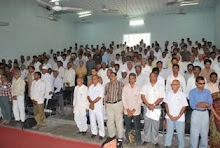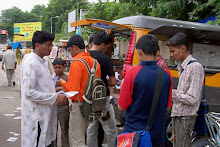Hindustan Times: New Delhi: Wednesday,
June 22, 2016.
The first
cut-off list is to be announced for undergraduate programmes at Delhi
University in five days. The question is: is the competition going to be as
fierce as it was last year?
In 2015, the
cut-offs for admission to Delhi University (DU) went up to 100% in certain
courses. Experts don’t expect things to change this year too.
According to
Rudrashish Chakraborty, member, DU academic council, “Expected cut-off this
year will be according to the applications received. If there are more students
with high marks, cut-offs will go up.” This situation is more likely given the
overall registrations, which number close to 3.4 lakh.
Conventionally,
the cut-offs are highest for commerce and the lowest for humanities. Till last
year, there were up to 12 cut-off lists for DU. The main reason was reshuffling
of seats because of OBC and SC/ST vacancies under the 27% and 22.5% quota that
remained in different colleges and courses.
What to
expect
Elaborating
on this year’s scenario, Dr Bharat Singh, member, DU academic council and
standing committee on admissions, says, “Earlier, when there were excess
admissions after the announcement of a cut-off list in the general category, we
had to compensate the number of seats for OBC and SC/ST candidates
proportionately. This time, not more than five cut-off lists will be published
and for the seats that remain, colleges will have to announce a fresh merit
list and give admission to candidates on a first-come-first-serve basis. For
instance, if a college has five vacant seats after the fifth cut-off in a
course, the college will invite fresh applications from candidates who had already
registered during the initial registration process. The best candidates will
then be selected for these slots based on merit. While this will reduce the
rush that is usually seen, it will also mean that the cut-offs will remain
high. The difference between the first and fifth cut-off list will also be
substantially reduced.”
Students who
meet the requisite cut-off need to select the college or course of their
choice. The colleges have to admit all the candidates who meet the announced
cut-off criteria. Admissions will not be on a first-come-first-serve basis till
the fifth cut-off list is announced. Those unable to take admission in a given
cut-off list can be considered for admission in the immediate next cut-off list
only on the last date of admission, subject to availability of seats.
“Students will not be able to take admission
in more than one course and one college at the same time. Also, five lists mean
admissions will be handled carefully with stringent checks and be stable in
most lists,” says Chakraborty.
No relief
“The cut-offs
are unlikely to drop significantly in each subsequent list for the most sought
after courses like BCom (hons), economics (hons), English (hons) and BCom
(pass), especially for general category candidates. There is provision of 2.5%
and 5% deduction for honours and pass courses, respectively, for a subject not
studied/change of stream,” says Dr Singh.
The cut-off
ceiling depends on the standard of CBSE evaluation and results. The penalty
clauses are mostly rational and logical. It is a measure to ensure a level
playing field for all the candidates from different streams, adds Dr Singh.
“My
experience says the drop in the second and the subsequent lists will be
marginal, depending on withdrawals,” adds Chakraborty.
This time
there will be no concept of uniform cut-offs as such in DU. “This does seem to
be feasible. Different DU colleges are quite heterogeneous in terms of
location, courses offered and infrastructure etc. The cut-offs are likely to
escalate by around 1% to 2% this year for different courses in different
colleges, especially in the first list,” says Dr Singh.
However,
there will not be any additional eligibility criterion for any category in any
college or course. “Additional eligibility criteria is no longer possible since
DU doesn’t allow colleges to have the same anymore. However, additional
eligibility criteria is meant to meet customised requirements of each
discipline. Commerce courses reduce marks of applicants if they have not
studied commerce subjects. A course in English (hons) gives advantage to
applicants who have studied elective English or English literature since it
makes sense academically. I agree that sometimes it makes things difficult for
applicants. The problem lies in school boards giving very high marks to
students which make admissions very difficult,” says Chakraborty.
While
empathising with applicants who have to deal with high cut-offs and penalty
clauses, Chakraborty feels colleges are not at fault for this. “Even with such
high cut-offs, colleges are saddled with over-admissions since students are
getting such high marks. There has to be some rationalisation done to marks
given by boards like CBSE which is the root cause of the problem. Since DU is a
Central university established by an Act of Parliament, it attracts students
from all parts of the country. Hence there is no variable impact of the
cut-offs on different boards. “However, because of CBSE’s obnoxious policy of
inflated marking, it has given rise to competitive inflation in marks among
other state boards who earlier used to be rational,” he says.
While the
number of students qualifying the Class 12 exam is going up every year by
thousands, seats in colleges have not been increased. “So a high cut-off has
more to do with lack of adequate number of colleges offering affordable quality
education,” adds Chakraborty.
Interestingly,
a committee was formed under Punya Srivastava, secretary, Directorate of Higher
Education, Delhi, last year to look into reasons for the high cut-offs.
An RTI filed
by Subhash Jha, a student of DU’s Cluster Innovation Centre, revealed that the
committee was given the task to explore the possibility of normalisation of
marks across various state boards vis-à-vis the CBSE.
Professor
Shyam Menon, vice chancellor, Ambedkar University Delhi, who was also a member
of this committee, says, “There was a meeting some time last year that the
secretary higher education of the Delhi government had convened and I had
attended. It was to discuss (among other things) the issue of high cut-offs in
DU colleges. What emerged from the deliberations in the meeting, was that the
major issue was that of the gap between the number graduating from the schools
in Delhi and the number of seats for freshers in undergraduate programmes in
the city.”














































































